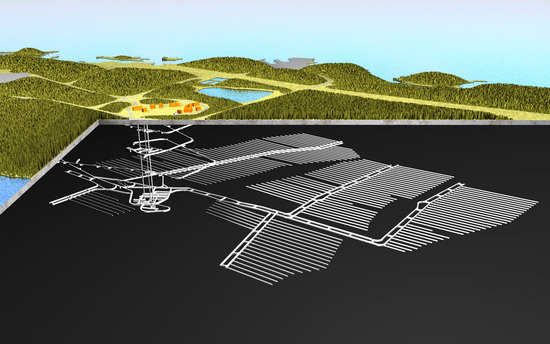Significant milestone for world-first underground repository
Posiva lays foundation stone for fuel encapsulation plant at Finland's Onkalu facility, expected to be operational by 2023.

Related Articles
Posiva – the Finnish waste management company, has laid the foundation stone for the used fuel encapsulation plant Onkalo, at Olkiluoto, with construction scheduled for completion in 2022.
Construction of the world’s first permanent underground nuclear storage facility (costing an estimated EUR500 million (US$550 million) began in 2016 and once complete, it will store up to 6,500 tons of waste. Operation of the repository is expected to begin in 2023.
Used fuel will be packed inside copper-steel canisters at the above-ground encapsulation plant, then transferred into the underground repository, located at a depth of 400-450 meters.
“Teollisuuden Voima Oyj (a joint owner of Posiva) has been working and doing research on the final disposal of nuclear fuel since the late 1970s,” Posiva Communications Manager Pasi Tuohimaa told Nuclear Energy Insider.
“The used fuel needs to be cooled down in temporary storage for at least 40 years, so the first moment to start final disposal is now.
“Posiva was established in 1995, when the Finnish law changed so no used nuclear fuel is allowed to be brought in to Finland or taken out. The other owner of Posiva, Fortum, had transported its used nuclear fuel to Russia prior to that.”
Posiva's final disposal plans based on the KBS-3 concept

Source: Posiva
At the stone laying ceremony on 23 September, Posiva CEO and President Janne Mokka said it was an important step in the preparatory phase which began in the 1980s.
“We are now about to take the preparations for final disposal to the implementation stage of the facilities; a stage which is unique on the global scale,” said Mokka. “Together with our competent partners we are making history in our industry.”
Posiva will complete repository excavation work in eight phases, which will allow cost management and provide new site data to inform subsequent decision making.
“The waste comes mainly from the same Olkiluoto island,” said Tuohimaa. “A lot less will come after 2035 from Fortum’s Loviisa plants, since their early fuel was sent to Russia.
“Onkalo will hold a maximum 6,500 tons of uranium fuel when finally closed after 100 years of operation some time in 2125.”
Leading the world
Sweden has plans for a similar used fuel encapsulation and disposal facility using the same storage method. Radioactive waste management company Svensk Kärnbränslehantering AB plans to start construction of its facility early in the 2020s and it will take around 10 years to complete.
“Posiva has been constructing Onkalo since 2015. Before that the digging down to 450 meters started in 2004 as a research project. The Swedes have not started any construction yet,” said Tuohimaa.
“This will be the first long-term repository. The concept is equal only with Sweden so far. Other countries, maybe except France, are far behind.”
In the US, an underground repository has been delayed by political opposition and conflicting research studies since 1987, when Yucca Mountain was designated by Congress as a nuclear waste storage site. The licensing process ground to a halt in 2011 when the Obama administration and Congress cut funding for hearings needed to settle challenges filed by stakeholders.
Just last month, The House Energy and Commerce subcommittee on environment and climate change passed a bill that would allow the Department of Energy to undertake “infrastructure activities” for Yucca Mountain. Despite the Trump administration backing the plan, it appears the legislation faces major challenges, not least as the site is located just 90 miles from Las Vegas.

The long road
Posiva studied the rock at Olkiluoto and prepared its licence application using results from the Onkalo underground laboratory, which will be expanded to form the repository. Posiva is still required to obtain a separate operating licence for the facility. However, Posiva says tests on its prototype storage technology are going well, and that the prototypes are “under development all the time”.
The road to get to this significant stage has been a long one, but Posiva says little has changed in those decades, while the main lessons learned have been “open and transparent communications” and “building long-term trust locally and nationwide”.
“People’s attitude is that is always better to place it down there than keep it in temporary storages on ground level,” said Tuohimaa.
Scott Birch
